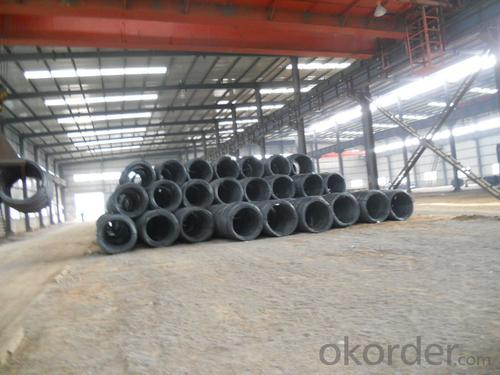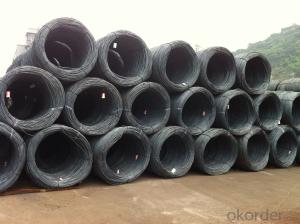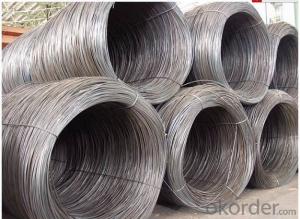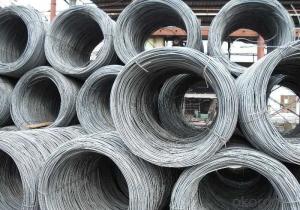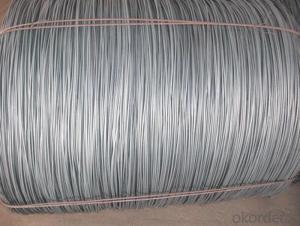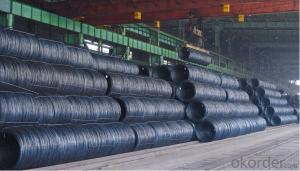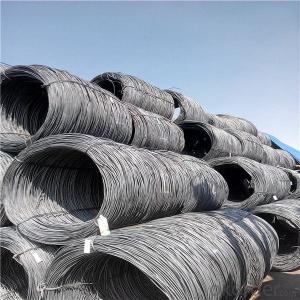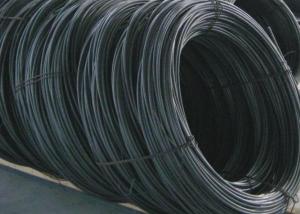China Supplier American Standard Steel Wire Rod
- Loading Port:
- China main port
- Payment Terms:
- TT or LC
- Min Order Qty:
- 50 m.t.
- Supply Capability:
- 200000 m.t./month
OKorder Service Pledge
OKorder Financial Service
You Might Also Like
Specifications of China Supplier American Standard Steel Wire Rod
Steel Grade: Q195/235, SAE1006-1018B Standard: ASTM, GB
Diameter: 5.5mm, 6.5mm, 7mm,8mm,9mm,10mm,12mm,14mm
Type: Drawn Wire Alloy or Not: Alloy Brand Name: HSKY
Technique: Hot Rolled Place of Origin: China Mainland
Chemical Composition of China Supplier American Standard Steel Wire Rod
(Please kindly find our chemistry of our material based on SAE1006B and SAE1008B as below for your information)
Grade | Chemical Composition (%) | |||||
C | Mn | S | P | Si | B | |
SAE1006B | 0.03~O.07 | 0.32max | 0.045max | 0.040max | 0.30max | 0.0008min |
Mechanical properties | ||||||
Yield strength(N/mm2) | Tensile strength(N/mm2) | Elongation (%) | ||||
250-280 | 350-380 | ≥32 | ||||
Grade | Chemical Composition (%) | |||||
C | Mn | S | P | Si | B | |
SAE1008B | 0.10max | 0.3~0.50 | 0.050max | 0.040 max | 0.15max | 0.0008 min |
Mechanical properties | ||||||
Yield strength(N/mm2) | Tensile strength(N/mm2) | Elongation (%) | ||||
≥195 | 315-430 | ≥30 | ||||
Usage and Applications of China Supplier American Standard Steel Wire Rod
After hot-rolled the products shaped into coil and delivery as finished product, including round, square, rectangular, hexagonal and so on, Since most of the products are round, it is generally called wire rod. Steel wire rod is widely used in construction and manufacturing. Steel wire rod is mainly used for reinforcement of reinforced concrete and welded structure or reprocessed (roberts, nail etc) materials, especially used to produce wire drawing, welding electrode, nails,spring, electronic, precise machinery parts and so on.
Packaging & Delivery of China Supplier American Standard Steel Wire Rod
Packaging Detail: products are packed in coil and then shipped by container or bulk vessel
Each coil weight: 2-3MT
Delivery Detail: within 45 days after received deposit or LC.
Label: to be specified by customer, generally, each bundle has 1-2 labels
Trade terms: CFR, CIF
Pictures of China Supplier American Standard Steel Wire Rod
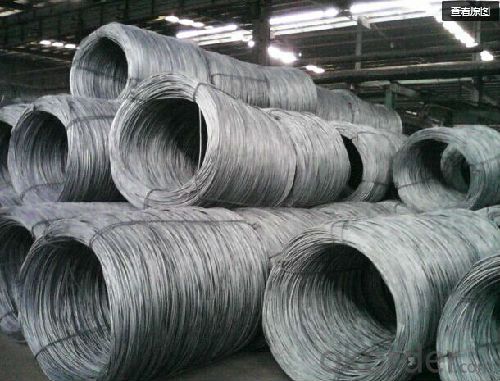
Steel Wire Rod in Coil in Container

Steel Wire Rod in Coil in Bulk Vessel

Note:
1. Our products are produced according to national standard (GB), if not, supply according to national standards (GB) or agreement as customer required.
2. Other Grade and Standard carbon steel wire rod we can supply:
Grade: H08A, 30MnSi, 62B-82B
Standard: AISI, BS, JIS, DIN
The Minimum Order Quantity of these products is high, and need to be confirmed.
3. We can not only supply carbon steel wire rod; if you need anything about building materials, please contact us.
4. Please send us your detail specifications when inquire. We will reply to you as soon as possible. We sincerely hope we can establish a long stable business relationship.
- Q: What are the different types of steel wire rod available?
- There are several different types of steel wire rod available, including low carbon steel wire rod, high carbon steel wire rod, alloy steel wire rod, and stainless steel wire rod. Each type has its own unique properties and is used in various applications such as construction, automotive, manufacturing, and electrical industries.
- Q: What are the main factors affecting the market acquisitions of steel wire rod?
- The main factors affecting the market acquisitions of steel wire rod include the overall demand for steel wire products in various industries such as construction, automotive, and manufacturing. Other factors include raw material costs, global economic conditions, competition from substitute materials, government regulations and policies, technological advancements, and the overall supply chain dynamics.
- Q: How does the fatigue strength of steel wire rod vary with different diameters?
- The fatigue strength of steel wire rod typically varies with different diameters. In general, as the diameter of the steel wire rod increases, the fatigue strength tends to decrease. This is because larger diameter rods have a higher likelihood of containing defects or imperfections, such as inclusions or microstructural irregularities, which can act as stress concentrators and reduce the fatigue strength. Additionally, larger diameter rods have a larger surface area, which can result in a higher chance of surface defects or corrosion, thus affecting the fatigue strength. Moreover, the larger diameter rods also tend to have a lower bending stiffness, which can lead to higher stresses and strains under cyclic loading and consequently reduce the fatigue strength. On the other hand, smaller diameter steel wire rods tend to have a higher fatigue strength due to their reduced surface area and fewer chances of containing defects. Smaller diameter rods also have a higher bending stiffness, which helps in distributing the applied load more evenly, reducing localized stress concentrations and improving fatigue strength. However, it is important to note that there are several other factors that can influence the fatigue strength of steel wire rods, such as the specific type and quality of the steel used, the manufacturing process, and the surface treatment. Therefore, it is necessary to consider these factors along with the diameter when evaluating the fatigue strength of steel wire rods.
- Q: What are the different types of steel wire rod surface finishes after wire drawing?
- There are several types of steel wire rod surface finishes that can be achieved after wire drawing. These include bright finish, black finish, galvanized finish, and coated finish. The bright finish is achieved by polishing the wire rod, resulting in a shiny and smooth surface. The black finish is obtained through a process called annealing, which involves heating the wire rod to a high temperature and then cooling it slowly, resulting in a darkened surface. The galvanized finish is achieved by applying a layer of zinc coating to the wire rod, providing protection against corrosion. Lastly, the coated finish involves applying a layer of specialized coating, such as PVC or nylon, to the wire rod for specific applications or enhanced properties.
- Q: How does the quality of steel wire rod affect its performance?
- The quality of steel wire rod directly affects its performance as it determines its strength, durability, and resistance to wear and tear. Higher quality steel wire rod will have a more consistent and uniform composition, leading to improved mechanical properties such as increased tensile strength and flexibility. It will also exhibit better corrosion resistance, making it suitable for various applications in construction, manufacturing, and engineering industries. Conversely, lower quality steel wire rod may have impurities, irregularities, or inconsistent composition, resulting in reduced performance and potentially compromising the safety and reliability of the products or structures it is used in.
- Q: What are the different types of wire mesh for filtration made from steel wire rod?
- There are several types of wire mesh for filtration made from steel wire rod, including woven wire mesh, welded wire mesh, and expanded metal mesh. Each type has its own unique characteristics and applications in filtration systems.
- Q: What are the main factors influencing the choice of steel wire rod order packaging marking options?
- When choosing the packaging marking options for steel wire rod orders, several factors come into play. Firstly, compliance with industry standards is crucial. Each industry may have its own specific requirements for markings on packaging materials. These standards ensure that the product can be easily identified and tracked throughout the supply chain. Adhering to these standards is essential for smooth operations and regulatory compliance. Secondly, customer requirements play a significant role. Customers may have specific labeling or marking preferences based on the destination of the product, their own branding needs, or other identification requirements. Meeting these requirements is vital for customer satisfaction and maintaining strong business relationships. Lastly, logistical considerations also impact the choice of packaging marking options. The way the steel wire rod orders are handled during transportation, storage, and loading/unloading can influence the placement of markings. For instance, if orders are frequently stacked or stored in specific orientations, the markings should be positioned accordingly to ensure easy identification and handling. Additionally, the size, shape, and material of the packaging itself need to be taken into account when determining the most suitable marking options. In conclusion, the choice of packaging marking options for steel wire rod orders is influenced by industry standards, customer requirements, and logistical considerations. By carefully considering these factors, businesses can ensure effective and efficient packaging marking solutions that meet the needs of all stakeholders involved.
- Q: How is steel wire rod used in the production of tire cords?
- Tire cords rely on steel wire rod, an indispensable element, for their production. These cords are embedded within the rubber of tires to offer strength and support. The steel wire rod undergoes a sequence of steps to achieve the desired form for tire cord manufacturing. To begin with, the steel wire rod undergoes hot rolling, which reduces its diameter and increases its length. This process enhances the wire rod's strength and flexibility, making it suitable for tire cord applications. Following hot rolling, the wire rod is subjected to a heat treatment known as patenting. This treatment improves the wire's mechanical properties, such as tensile strength and elasticity, ensuring it can endure the demanding conditions tires face. Once appropriately processed, the steel wire rod is drawn through a series of dies to attain the desired diameter and surface finish. This drawing process further enhances the wire's strength and surface quality, meeting the strict requirements for tire cord production. Next, the drawn steel wire rod is coated with a layer of brass or zinc to enhance its adhesion to the rubber compound used in tire manufacturing. This coating also provides corrosion resistance, extending the lifespan of the tire cords. Lastly, the coated steel wire rod is twisted into cord structures with multiple strands, forming the tire cord. These cords are then embedded into the rubber during the tire manufacturing process. They play a vital role in reinforcing the tire, enabling it to withstand internal pressure, external forces, and maintain stability during vehicle movement. In conclusion, steel wire rod is an essential material in the production of tire cords. Through a series of processing steps, including hot rolling, heat treatment, drawing, and coating, the wire rod is transformed into durable and high-strength cords. These cords are embedded within the rubber of tires to provide crucial reinforcement and support, ensuring the tires can endure the challenging road conditions they encounter.
- Q: How is steel wire rod used in the manufacturing of wire rope swivels?
- Steel wire rod is used in the manufacturing of wire rope swivels as the primary material for creating the rope itself. The wire rod is carefully twisted and braided to form the wire rope, which provides the strength, durability, and flexibility required for the swivel to function effectively.
- Q: Can steel wire rod be used in the production of nails?
- Yes, steel wire rod can be used in the production of nails.
Send your message to us
China Supplier American Standard Steel Wire Rod
- Loading Port:
- China main port
- Payment Terms:
- TT or LC
- Min Order Qty:
- 50 m.t.
- Supply Capability:
- 200000 m.t./month
OKorder Service Pledge
OKorder Financial Service
Similar products
Hot products
Hot Searches
Related keywords



